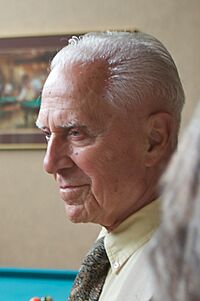Richard Oriani facts for kids
Quick facts for kids
Richard Oriani
|
|
|---|---|

Richard Oriani
|
|
| Born | July 19, 1920 San Salvador, El Salvador
|
| Died | August 11, 2015 (aged 95) Edina, Minnesota, U.S.
|
| Alma mater | College of the City of New York (B.S) Princeton University (Ph.D) |
| Spouse(s) | Constance Oriani |
| Children | 4 |
| Awards | Alexander von Humboldt Award (1984) W.R. Whitney Award of the National Association of Chemical Engineers |
| Scientific career | |
| Fields | Metallurgy, cold fusion |
| Institutions | University of Minnesota |
Richard A. Oriani (born July 19, 1920 – died August 11, 2015) was an important American scientist. He was born in El Salvador. He was a chemical engineer and a metallurgist. These are people who study how metals work and how to make them stronger. Oriani was especially known for his work on how a gas called hydrogen affects metals. He also did important research on something called cold fusion.
Contents
Early Life and Education
Richard Oriani was born in El Salvador in 1920. His mother was from Spain and his father was from Italy. When Richard was 9 years old, his family moved to the United States. They settled in Brooklyn, New York. He lived there with his parents, his brother Ernest, and his sister Elena.
In 1943, Oriani finished his degree in chemical engineering. He studied at the College of the City of New York. Even though he was a top student, it was hard for him to find a job at first. This was because his father had an Italian passport, which made Richard an "enemy alien" during World War II.
However, one of his professors helped him get a job. He started working at the Bakelite Corporation Research Laboratory. There, he studied how things stick together, called adhesion. He also helped create a special glue for the military. This work meant he did not have to join the Army. In 1948, he earned his Ph.D. in physical chemistry from Princeton University.
Research and Discoveries
After getting his Ph.D., Oriani worked at the General Electric Research Laboratory in Schenectady, New York. He was a research associate there for ten years. He studied many things, including how metals change and how hydrogen behaves inside metals. He even helped confirm a method to make diamonds in the lab.
Later, Oriani moved to U.S. Steel's Bain Laboratory. He became an assistant director and researcher. His work there focused on how metals can break down. He became very respected for his advancements in understanding hydrogen embrittlement. This is when hydrogen gas makes metals, especially steel, weak and brittle.
Oriani developed a theory about how hydrogen moves through metal. He explained how it can gather in tiny flaws, making the metal break easily. His ideas helped scientists understand why important building materials can suddenly fail. Other researchers later built on his work.
In 1980, Oriani retired from U.S. Steel. He was then invited to work at the University of Minnesota. He became a professor and director of a new center for studying corrosion. Corrosion is when metals slowly get damaged, like rust. He retired from the university in 1999. But he kept an office and continued his research there until 2014.
While at the University of Minnesota, Oriani also started using a tool called the Kelvin probe. He used it to study how metals corrode in different environments. This included how humidity can cause corrosion.
Work on Cold Fusion
In 1989, Oriani's research expanded into the field of cold fusion. This was a new and debated area of science. In 1990, he confirmed findings by other scientists about "excess energy" in a special type of battery. He used a very precise way to measure heat, called calorimetry.
Oriani then focused on finding out if this extra energy came from nuclear reactions. He looked for and measured tiny nuclear particles released during these reactions. He worked with many other scientists and thinkers in the field. He published at least nine papers about nuclear reactions that current science could not fully explain. Oriani believed that if cold fusion became real, it would open up a whole new area of nuclear physics.
Personal Life
Richard Oriani was also a talented musician. He taught himself to play the viola and the piano. He met his wife, Constance, at a music group in New York. They got married in 1949 and had four children.
Death
Richard Oriani passed away on August 11, 2015, in Edina, Minnesota.
Awards and Honors
- Fellow of the Electrochemical Society, 1994
- Fellow of NACE (National Association of Corrosion Engineers)
- Alexander Von Humboldt Prize, 1984
- The W.R.Whitney Award of the National Association of Corrosion Engineers
- Fellow, American Society for Metals

